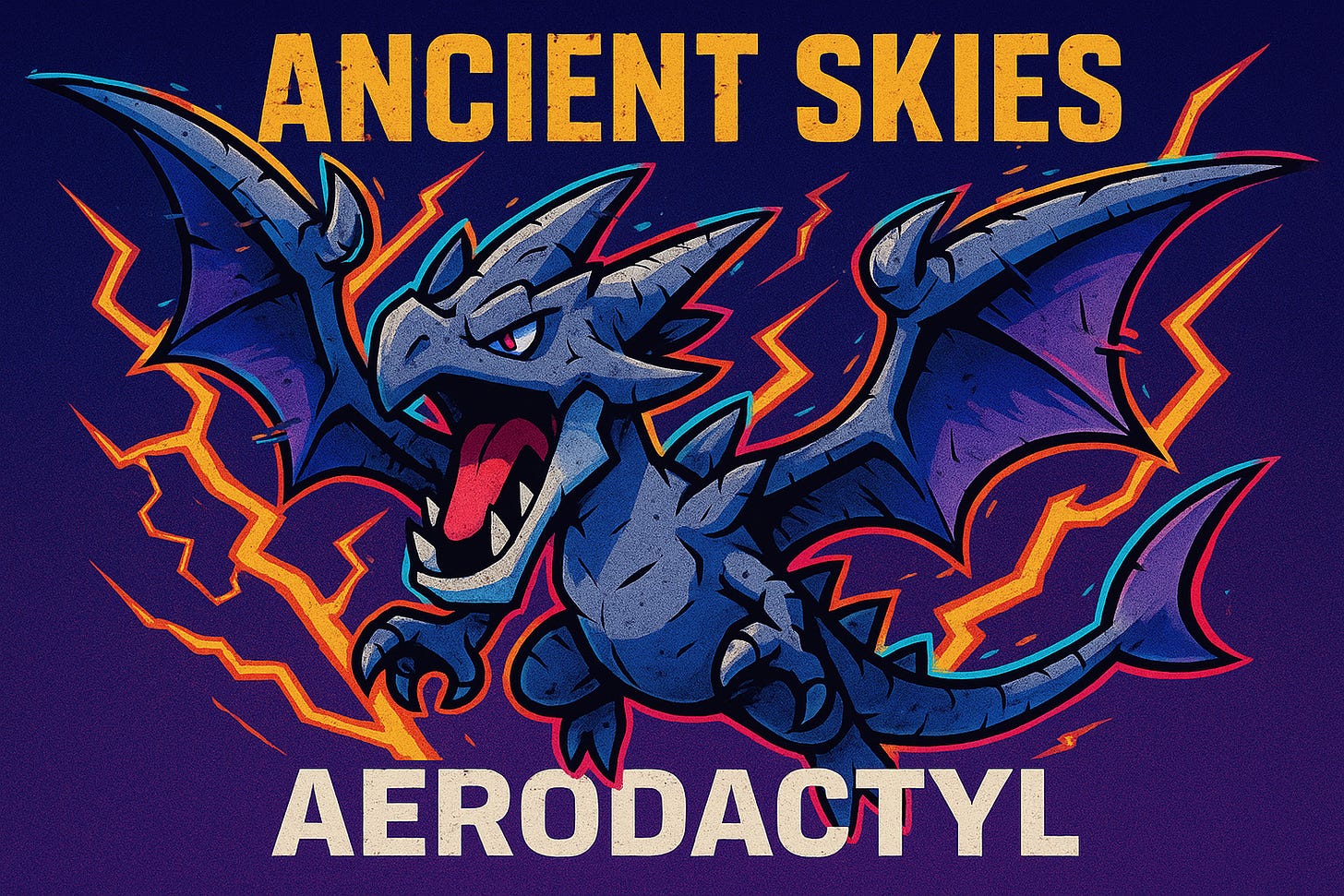“Ancient Skies”
Awakened from a fossil’s sleep,
Aerodactyl rules the deep.
A scream of stone, a primal cry,
Ancient terror splits the sky.
A shadow king of ancient air,
Predator born from ages rare.
Wings like blades, a sharpened storm,
A sky where ancient fears are born.
Then Mega claws ignite the flame,
More savage still, he claims his name.
Spikes of stone, a crown of might,
The fossil king commands the night.
From rock to sky, from past to now,
The ancient lord still keeps his vow.
No cage, no time, no chain can bind,
The first of flight, the last of kind.
Ancient Wings: The Myth and Science of Aerodactyl
In the fossil halls of Pokémon’s prehistory, one name hovers like a shadow with teeth: Aerodactyl — the primordial sky tyrant said to have ruled the air before humankind ever learned to name it. To trainers, it’s a relic of ancient power. To lorekeepers, it’s a parable about our fascination with extinction and our temptation to reverse it.
Aerodactyl first appeared in Pokémon Red and Blue as a gift from amber — the DNA of the ancient world suspended in golden sap. The player resurrects it using the Old Amber, echoing Jurassic Park’s central fantasy: that DNA, preserved perfectly enough, could resurrect the dead. But what began as game mechanics evolved into something stranger — a meditation on scientific hubris.
The Fossil’s Whisper
In Pokémon canon, Aerodactyl’s origins are half scientific, half mythical. It’s described as a “ferocious prehistoric Pokémon that dominated the skies,” whose roar caused terror across continents. Yet it’s not just an apex predator; it’s a ghost revived by human hands. The process that returns Aerodactyl to life — “reanimation from DNA extracted from amber” — mirrors our real-world ambitions in de-extinction: cloning mammoths from frozen tissue, recreating passenger pigeons from CRISPR editing.
Each attempt raises the same question Aerodactyl embodies: just because we can bring something back, should we?
Mythic Overtones
In older Japanese Pokémon materials, Aerodactyl’s name — プテラ (Putera) — comes from pteranodon and tera, meaning “monster” or “earth.” It’s not a literal pterosaur but a mythic synthesis: bat-winged, dragon-fanged, yet strangely mammalian. It’s a creature from a world that might have never existed, yet feels archetypal — the ur-dragon of all our fossil dreams.
The lore of Aerodactyl thus belongs to a long human tradition: imagining the past as prophecy. Medieval Europeans found fossil bones and thought they were dragons. The Chinese called them thunder-beasts. In the Pokémon world, those myths became manifest — and science, in its curiosity and arrogance, made them live again.
Resurrection as Mirror
In-universe, Aerodactyl is often uncontrollable, a violent reminder that life taken from the fossil record resists domestication. The Mega Evolution — Aerodactyl’s modern mutation — only amplifies this irony: technology, again, refines power beyond what nature once allowed. Its skin cracks open to reveal primal energy, as if the act of modern enhancement reawakens something ancient and wild beneath the veneer of control.
The story of Aerodactyl, in this sense, isn’t about the past at all. It’s about the future.
From Fossil to Philosophy
Aerodactyl’s lore captures the central tension of human progress — our awe before nature’s ruins, and our refusal to leave them buried. The Pokémon universe, for all its charm, channels a deep anxiety about scientific resurrection. When we extract DNA from amber, we aren’t just reviving a fossil. We’re resurrecting an idea — that extinction can be undone, that mortality is negotiable.
But Aerodactyl’s scream reminds us otherwise: life returns, but not unchanged. The resurrected creature is neither past nor present — it’s something new, born from nostalgia and nerve.
In that, Aerodactyl remains less a monster than a mirror. It shows us our ambition to master nature’s timeline — and our fear that, in doing so, we might only reanimate the ghosts we were meant to study.



